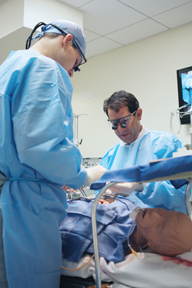By Josh Grossberg
Becoming a doctor requires years of attending lectures, watching PowerPoint presentations and reading stacks of thick textbooks filled with charts and graphs.
But at some point, young students and physician residents at Los Angeles County + USC will have to put down the heavy tomes and pick up a scalpel or a needle holder to begin the work of helping to make patients better.
To help them reach that goal as skillfully as possible, the Department of Surgery at the Keck School of Medicine of USC provides them with a variety of simulation options to teach procedural based skills. This provides the opportunity to practice — and practice some more — before they ever touch a patient. Now, students and young physicians can hone their skills in an environment that is safe, but also real enough to mimic the stress of a real-life situation.
“Historically, a student’s first experience performing simple procedures on a patient occurred in a clinical, and often stressful setting,” said program Executive Director Maura Sullivan, PhD. “It sounds really simple, but practicing those skills first is important.”

Craig Baker (right) and second year resident John Cleveland (left) perform a surgical simulation at the Surgical Skills Simulation and Education Center. (Photo/Ryan Ball)
Originally built as one room at its opening in 2000, the Surgical Skills Simulation and Education Center has expanded to include three distinct facilities scattered across the Health Sciences Campus. These facilities include an inanimate laboratory that houses a virtual operating room, an animate facility and a fresh-tissue dissection laboratory.
The three labs offer vastly different opportunities, not only for students, but also for residents and seasoned doctors from every discipline who want to learn a new technique or practice an old one. “Having three facilities allows us to design the most optimal training environment” said Sullivan.
The inanimate lab features laparoscopic and endoscopic simulators, a virtual operating room, a simulation suite and numerous bench models for practicing procedures. The animate lab provides the opportunity to work on live animal models mimicking full surgical procedures.
The third facility is the fresh-tissue dissection lab. This unique part of the program is run in partnership with the LAC + USC Medical Center, and provides access to cadavers utilized for resident education. Recently, a perfused model has been developed to completely simulate the realism of surgical procedures. Understanding the real benefits of improving patient safety, LAC+USC has provided a generous grant allowing all residents at LAC+USC the ability to benefit from this unique educational resource.
“Our various training facilities provide an opportunity to expose physicians to invasive skills at an earlier time in their training. We expect this will create more qualified and competent physicians and improve patient safety and outcomes in the future,” added Craig Baker, MD, vice chair of surgical education and program director for thoracic surgery.
Although many of the tools available are high tech, a simulation is any procedure that is done in a nonclinical setting with the goal of learning and honing procedural skills. “It can be tying knots with a piece of rope,” said Sullivan. “It can be suturing on a pig’s foot. You don’t need the highest technology to teach the simple skills.”
“It’s not just going through the motions, these simulators model real life procedures and allow trainees to gain proficiency in a nonstressful environment,” said simulation specialist Mike Minneti. “They have to use the needle in the same way it would be done in a clinical setting.”

